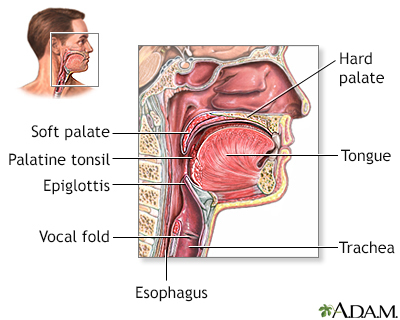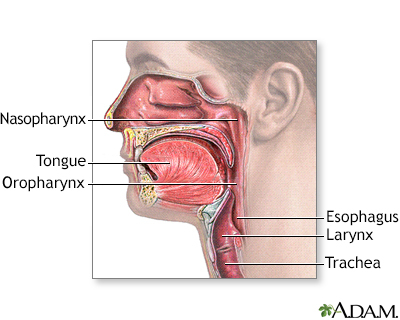The dark side of social media: e-cigarettes targeting young adults
These days, electronic cigarettes, or e-cigarettes, are everywhere — even in the hands of young adults. But because e-cigarettes are such a new product, their…

Update your location to show providers, locations, and services closest to you.
Throat cancer is cancer of the vocal cords, larynx (voice box), or other areas of the throat.
Vocal cord cancer; Throat cancer; Laryngeal cancer; Cancer of the glottis; Cancer of oropharynx or hypopharynx; Cancer of the tonsils; Cancer of the base of the tongue
People who smoke or use tobacco are at risk of developing throat cancer. Drinking too much alcohol over a long time also increases risk. Smoking and drinking alcohol combined lead to an increased risk for throat cancer.
Most throat cancers develop in adults older than 50. Men are more likely than women to develop throat cancer.
Human papillomavirus (HPV) infection (the same virus that causes genital warts) account for a larger number of oral and throat cancers than in the past. One type of HPV, type 16 or HPV-16, is much more commonly associated with almost all throat cancers.
Symptoms of throat cancer include any of the following:
The health care provider will perform a physical exam. This may show a lump on the outside of the neck.
The provider may look in your throat or nose using a flexible tube with a small camera at the end.
Other tests that may be ordered include:
The goal of treatment is to completely remove the cancer and prevent it from spreading to other parts of the body.
When the tumor is small, either surgery or radiation therapy alone can be used to remove the tumor.
When the tumor is larger or has spread to lymph nodes in the neck, a combination of radiation and chemotherapy is often used to save the voice box (vocal cords). If this is not possible, the voice box is removed. This surgery is called a laryngectomy.
Depending on what type of treatment you require, supportive treatments that may be needed include:
You can ease the stress of illness by joining a cancer support group. Sharing with others who have common experiences and problems can help you not feel alone.
Throat cancers may be cured when detected early. If the cancer has not spread (metastasized) to surrounding tissues or lymph nodes in the neck, about one half of patients can be cured. If the cancer has spread to the lymph nodes and parts of the body outside the head and neck, the cancer is not curable. Treatment is aimed at prolonging and improving quality of life.
It is possible but not fully proven that cancers which test positive for HPV may have better outlooks. Also, people who smoked for less than 10 years may do better.
After treatment, therapy is needed to help with speech and swallowing. If the person is not able to swallow, a feeding tube will be needed.
The recurrence risk in throat cancer is highest during the first 2 to 3 years of diagnosis.
Regular follow-up after the diagnosis and treatment is very important to increase the chances of survival.
Complications of this type of cancer may include:
Call your provider if:
Do not smoke or use other tobacco. Limit or avoid alcohol use.
HPV vaccines recommended for children and young adults target HPV subtypes most likely to cause some head and neck cancers. They have been shown to prevent most oral HPV infections. It is not clear yet whether they also are able to prevent throat or larynx cancers.


Armstrong WB, Vokes DE, Tjoa T, Verma SP. Malignant tumors of the larynx. In: Flint PW, Francis HW, Haughey BH, et al, eds. Cummings Otolaryngology: Head and Neck Surgery. 7th ed. Philadelphia, PA: Elsevier; 2021:chap 105.
Garden AS, Morrison WH. Larynx and hypopharynx cancer. In: Tepper JE, Foote RL, Michalski JM, eds. Gunderson & Tepper's Clinical Radiation Oncology. 5th ed. Philadelphia, PA: Elsevier; 2021:chap 41.
Lorenz RR, Couch ME, Burkey BB. Head and neck. In: Townsend CM Jr, Beauchamp RD, Evers BM, Mattox KL, eds. Sabiston Textbook of Surgery. 20th ed. Philadelphia, PA: Elsevier; 2017:chap 33.
National Cancer Institute website. Nasopharyngeal cancer treatment (adult) (PDQ) - health professional version. www.cancer.gov/types/head-and-neck/hp/adult/nasopharyngeal-treatment-pdq. Updated August 30, 2019. Accessed February 12, 2021.
Rettig E, Gourin CG, Fakhry C. Human papillomavirus and the epidemiology of head and neck cancer. In: Flint PW, Francis HW, Haughey BH, et al, eds. Cummings Otolaryngology: Head and Neck Surgery. 7th ed. Philadelphia, PA: Elsevier; 2021:chap 74.
Our community and patient programs provide great value to patients, families and loved ones. People can find support, educational materials, expert consultants and more. In most instances, these programs are offered free of charge.
Improves health and quality of life for long-term cancer survivors.
Pain management treatment plans for cancer patients.
Helps individuals access high-quality cancer screening, prevention and treatment services.
These days, electronic cigarettes, or e-cigarettes, are everywhere — even in the hands of young adults. But because e-cigarettes are such a new product, their…

Each year over 50,000 Americans are diagnosed with head and neck cancers, including those of the oral cavity and pharynx. As surgical and adjuvant treatments…
